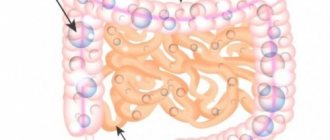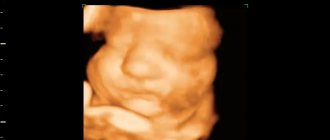Infant digestion
A newborn is constantly in a state of adaptation to new living conditions. Its organs and systems continue to develop, and the physiological mechanisms of defecation are also improved.
In an adult, the retention of feces in the rectum is ensured by involuntary and voluntary, that is, subject to the will, contractions of its muscles - the sphincters.
The urge to defecate occurs when stool comes into contact with the lower intestine. An adult is able to control the urge, but a newborn child is not.
The milk enters the stomach and triggers a gastrointestinal reflex, generating a wave of peristalsis throughout the gastrointestinal tract. Feces fall into the rectum and cause the urge to defecate. Not realizing that the conditions for defecation are, to put it mildly, unsuitable, the baby draws in his legs and strains. Emptying your bowels makes room for more food.
The frequency of stool in a newborn often coincides with the frequency of feedings, but it can be twice a day3. The feces have a yellow or yellow-brown color, sometimes with a greenish tint, a mushy consistency mixed with foam and inclusions reminiscent of cottage cheese, and the smell of sour milk.
Starting at about 2 months, the frequency of stools begins to gradually decrease. By the time complementary foods are introduced (by 4-6 months), most infants have bowel movements 2 times a day, and some - once every 2 days3. The feces thicken and take on a sausage shape - this is what all small children should have.
Up to contents
Mother's diet
Source: Alexander Dummer: Pexels
Breastfeeding mothers often wonder how their diet affects the quality of their breast milk and how choosing foods for it can affect the baby's digestive system. However, most women do not need to restrict their diet while breastfeeding and should aim for a nutritious and varied diet.
In some cases, infants may seem to avoid feeding after the mother has taken certain foods. In this case, a woman can simply eliminate this food from her diet and return to it after stopping breastfeeding.
Important: Special recommendations include avoiding caffeine while breastfeeding. Caffeine is easily transmitted to the baby through milk. It reduces the amount of iron in milk, which can lead to iron deficiency anemia. It is recommended that a nursing mother consume no more than 400 milligrams of caffeine per day. The most caffeine is found in coffee and chocolate, and the least in tea.
A healthy diet while breastfeeding is essentially the same as a nutritious diet without breastfeeding. The main difference is that breastfeeding people need 450 to 500 extra calories per day. But if you want to lose weight after pregnancy, you can do without them, having first discussed this with your doctor.
A healthy diet for a pregnant woman includes:
- Fruits, especially rich in potassium and vitamin A (melon, banana, apricot, mango, oranges). Helps reduce the risk of constipation in both the child and the mother;
- Vegetables containing vitamin A and potassium (spinach, carrots, tomatoes, red peppers);
- Grain products, especially brown rice and whole grain bread;
- Protein-containing foods such as beans, peas, nuts, meat, fish, mussels.
Important: A nursing mother needs to drink a lot of water, especially in the first weeks after birth. Lack of fluid negatively affects milk production. A sufficient amount of water ensures the efficient functioning of the digestive system, helps food to be absorbed, which means breast milk will be well-balanced in nutrients. The higher the conditional quality of milk, the lower the likelihood of constipation in a child, since balanced milk improves peristalsis and fecal removal.
What should be considered constipation in an infant?
It is understandable that the lack of stool in a baby causes concern for parents and often becomes the reason for unnecessary self-medication. On the other hand, lack of basic knowledge about the proper frequency of bowel movements in children sometimes leads to delays in necessary treatment and complications. Therefore, first, let’s figure out what constipation is.
According to generally accepted opinion, constipation in babies under three months of age is considered to be a delay in bowel movements for 2-3 days. If difficulties with bowel movements persist for two or more weeks, they speak of chronic constipation.2,3. At the same time, the frequency of stool decreases (in comparison with individual characteristics3), the feces become dense, fragmented, and acquire an unpleasant putrefactive odor.
To empty the intestines, the child strains hard and for a long time, his face turns red, his legs are drawn up to his stomach. Sometimes the contents of the rectum are so hard that they injure the delicate mucous membrane and cause painful cracks to form. In this case, the baby cries, and a strip of scarlet blood appears on the surface of the stool.
Constipation affects the general condition of the baby. He experiences pain and bloating in the abdomen, popularly called “colic,” he eats poorly, becomes lethargic and moody.
It is the appearance of common symptoms of constipation in a breastfed newborn that serves as a guideline for diagnosis4. If they are absent, the child eats well, does not spit up, gains weight normally, the condition is considered to be “pseudoconstipation”, which does not require any intervention4.
Up to contents
How to find out the reason?
Symptomatic measures that induce defecation become addictive over time and lose their properties. Therefore, one cannot hope that the child will grow up and everything will return to normal “by itself.” It is important that it is in the infant period that the conditions for pathology in adulthood are formed. Therefore, if there are repeated problems with stool retention, it is necessary to conduct an examination and find out the cause.
Ultrasound of the abdominal cavity can reveal congenital pathology. In mild cases, it is treated with conservative methods. If there are significant changes, you should agree to surgery. Consultation with a neurologist helps to find out the cause of intestinal atony. A pediatric gastroenterologist will monitor the baby’s diet, identify lactulose deficiency and provide nutritional recommendations.
Your child may need to be tested for food allergies.
Why might a newborn be constipated while breastfeeding?
Difficult bowel movements and lack of stool in infants in 95% of cases are caused by various functional disorders in the intestines1,5. The remaining 5% is due to diseases that disrupt the formation, movement and excretion of feces1,5.
Organic constipation
This type of defecation disorders is most often detected in the first days or months of a baby’s life1,3. Its cause is anomalies in the development of the intestine and rectum in particular, various neurological diseases accompanied by slowing and incoordination of gastrointestinal motility, metabolic disorders against the background of reduced function of the thyroid gland and brain centers regulating the endocrine system, cystic fibrosis, Hirschsprung's disease1,3.
In order not to miss these diseases, if constipation occurs in children from birth to 3 months, it is better to immediately consult a doctor. If the examination does not reveal any organic pathology, we are talking about functional constipation3.
Functional constipation
The nervous system is of great importance in the regulation of stool, and since it is not yet sufficiently developed in a newborn, there is always room for constipation to occur. Functional constipation against the background of intestinal dyskinesia, accompanied by weakened peristalsis or spastic contractions of the intestine that disrupt its patency, is the most common type of disorder3.
Other causes of functional constipation in infants:
- immaturity of the child and his digestive system, accompanied by a late “start” of digestive enzymes, long-term retention of food masses in the stomach and intestines, imperfection of the receptor apparatus of the rectum, which triggers defecation3;
- consequences of intrauterine oxygen starvation, affecting the functioning of the central nervous system and the regulation of intestinal motility;
- general muscle weakness of the baby due to prematurity, iron deficiency or active treatment of rickets with vitamin D3;
- intestinal dysbiosis, which occurs, for example, when antibiotics and pathogenic microbes influence the weak and unstable microflora of the children’s intestines3;
- allergy to cow's milk proteins: it can appear already during breastfeeding if the mother loves dairy products and often consumes them4.
Up to contents
How to deal with constipation in the first months of a baby's life
Before taking any measures against constipation, it is necessary to have a correct understanding of what are signs of constipation and what can be attributed to the physiological norm.
Signs of constipation:
- 1 - stool less than once a day
- 2 - lack of appetite
- 3 - bloating
- 4 - sleep disturbance, general restlessness, moodiness
- 5 - gases with the smell of rot
- 6 - dense stool streaked with blood
- 7 - slow weight gain
The above symptoms may appear separately or in combination. The presence of constipation in a child can be definitively determined by assessing the general physical condition and well-being. If your baby has a good appetite and weight gain is normal, there is no serious cause for concern.
Temporary stool disorders
Difficulty in defecation may be temporary. Many babies experience difficulty with bowel movements - they strain, grunt, and whine during bowel movements, although their stool remains soft and mushy. This condition is quite normal for children in the first two months of life; it is associated with the immaturity of the nervous system and is called “dyschezia”4.
Temporary disruption of bowel movements in a child may be due to the following factors:
- lack of fluid - in some cases the child needs to be supplemented with food, although some mothers believe that when breastfeeding, the baby receives a sufficient amount of fluid in the form of milk2.5;
- general dehydration of the baby against the background of high fever, vomiting and diarrhea, for example, with an intestinal infection or ARVI, when a large amount of water is lost through sweat, vomit and liquid feces 4;
- malnutrition of a nursing mother: a small amount of fluid, following an unbalanced diet, low fiber content and a large number of “fixing” foods in the diet2;
- underfeeding of the child due to a deficiency of breast milk (in this case, the woman may not even suspect that she has little milk) and the mother’s “tight” breasts, general weakness and persistent regurgitation in the baby2,5;
- too early and irrational introduction of complementary feeding2;
- abuse of enemas and means of mechanical stimulation of defecation in a child (gas tube, irritation of the anus, etc.)2;
- psychological factors2, which include the mother’s psycho-emotional problems, the absence of a mother and getting used to a nanny, moving, frequent contacts with new people;
- any diseases and teething - they affect not only the well-being, but also the emotional and psychological state of the child, and at the same time - on intestinal motility.
Elimination of all of the above factors leads to spontaneous normalization of the child’s stool.
Up to contents
Prevention Tips
Parents of a small child need to know about measures to prevent constipation. These include:
- maintaining breastfeeding for at least six months;
- careful selection of formula if breastfeeding is not possible;
- introduce the first complementary foods no earlier than 5 months;
- the volume of the mixture and feeding regimen should be strictly observed according to the child’s age;
- additionally give boiled water, raisin decoction, dried fruits to drink;
- if there is a tendency to retain stool, do not feed the baby semolina and rice porridge, introduce prune puree;
- Do exercises and outdoor games with your baby;
- before feeding, do not forget to keep the baby in the tummy position;
- in hot weather, give more fluids, do not overheat due to too warm clothes;
- If you need to take antibiotics, ask your doctor about probiotics;
- A nursing mother needs to monitor the intake of medications that affect intestinal tone; vitamins with iron, sedatives, and antispasmodics can lead to constipation.
It is better to prevent the problem of constipation in children than to treat it. Parents are required to pay attention and understanding of the baby's condition. A nursing mother is the child’s main protection, so she needs to be protected and conditions created to prolong lactation.
What to do for constipation in a newborn while breastfeeding
You need to act based on the cause of constipation. When organic constipation is diagnosed, treatment for the underlying disease is prescribed by a doctor. Solving the problem leads to normal bowel movements.
For functional constipation, doctors recommend:
Breastfeed2.
Breast milk, containing the mother’s immune factors, provides the baby’s natural protection from infections, promotes the formation of his intestinal microflora and the development of the digestive system as a whole2. In case of weak lactation and lack of breast milk and unstable stool with a tendency to constipation in a child, doctors recommend supplementary feeding with adapted milk formulas with the addition of prebiotics2. They help maintain intestinal microflora, on which digestion partly depends2.
Follow the diet of a nursing mother
The composition of breast milk directly depends on the mother's nutrition, therefore, by changing nutrition, you can influence the baby's diet4. For the functioning of the baby’s gastrointestinal tract, it is important to maintain a water regime, vegetables, fruits, cereals, wholemeal bread eaten by the mother, that is, foods high in fiber4. You should limit the consumption of foods that provoke increased gas formation: cabbage, onions, tomatoes, rice, legumes, black bread, pears, grapes, mushrooms, pickles, smoked meats and spices3.
Prunes, dried apricots and simple boiled beets will help as a natural laxative during breastfeeding for constipation in a newborn - you just need to include them in the diet.
Fermented milk products are useful for maintaining intestinal microflora2. But if a child is diagnosed with intolerance to cow's milk, the nursing mother will have to completely abandon dairy products made from it4.
Keep your child physically active
A well-organized daily routine and physical activity are the most important factors in the treatment of constipation in a child2. Physical activity is selected individually according to the age of the child2. For newborns and infants during the first 5 months of life, their natural activity and special gymnastics are sufficient2. It is very important that clothes do not restrict the child’s movement and allow him to independently improve his motor skills in the process of exploring the world.
Do a belly massage
First of all, after feeding, you must keep the baby in an upright position so that he burps air, and then lay him on his tummy.
Abdominal massage involves lightly stroking the tummy in a clockwise direction, that is, in a circle, starting from the right iliac region and ending with the left iliac region. In this case, the child should lie on his back. At the end of the procedure, you need to hold the ankle joints and press the baby’s legs one by one to the tummy. This stimulates the passage of gases and bowel movements.
Use gas-reducing products wisely
A large amount of gases stretches the intestinal walls, weakens its peristalsis and leads to colic. Dill water, light fennel tea, and simethicone-based medications can relieve symptoms associated with constipation4.
In some cases, means that help mechanically remove gases from the intestines are useful, for example, a gas tube or enemas4. However, their frequent use aggravates the problem of constipation: the baby’s gastrointestinal tract begins to “become lazy” and ceases to independently perform its functions3.
Microclysters MICROLAX®
In the complex treatment of constipation in breastfed newborns, microenemas occupy a special place. They promote bowel movements and thereby alleviate the baby’s suffering.
MICROLAX® for children from 0 years old was created for the smallest children, equipped with a special short “spout” and can be used from birth to 3 years6. The drug contains sodium citrate, which displaces water from the stool, sodium lauryl sulfoacetate, which thins the contents of the rectum, and sorbitol, which stimulates the flow of water into the intestines6.
By enhancing each other's action, MICROLAX® components are able to soften stool and facilitate bowel movements6. In this case, the effect of the drug can begin in 5-15 minutes6.
It is important that the effect of MICROLAX® is limited to the final intestine. It is not absorbed, does not enter the general bloodstream and therefore does not affect the functioning of other organs and systems6.
For ease of use, MICROLAX® is available in the form of a disposable microenema equipped with a shortened spout tip6. It is enough to break off the seal and the microenema with 5 ml of the drug will be ready for use.
Up to contents
How to help a child?
Before thinking about what is best to do and how to help the child, experts recommend observing the nature of bowel movements. There are 2 options:
Bifidumbacterin for newborns for constipation and reviews about it
- atonic - the baby screams and strains, the initial portion of feces comes out with difficulty and with pain, it is formed feces like in adults, then liquid feces are released;
- spastic - feces come out in “sheep” portions, dense, the stomach is swollen, defecation is painful.
In the first case, it is necessary to stimulate intestinal contractility, in the second - to relieve spasm. Abdominal massage helps a newborn with constipation. With atony, it is necessary to increase muscle tone. To do this, exercise with the baby: in a supine position, bend the legs at the knees and bring them to the chest, then straighten them. The exercises are repeated several times a day when changing the diaper.
The development of the abdominal muscles is promoted by laying on the stomach for 10 minutes before each feeding. Stroking massage movements with your hand along the stomach in a clockwise direction will help get rid of cramps. In this case, you can apply light pressure. They use a warm diaper on the stomach, bathing in the bath, pressing and warming the baby's tummy to the body of the mother or father.
The following measures are recommended to stimulate stool:
- massage with two fingers of the paravertebral zone from the lower back to the sacrum;
- insertion shallowly into the anal passage of a cotton swab lubricated with baby cream and scrolling movements inside;
- sometimes a gas tube helps, first a gas plug comes out, then feces;
- grandmothers effectively used sticks cut from soap; you cannot use “Household” because of the presence of alkalis, it is better to take “Children’s”;
- It’s more convenient to purchase rectal suppositories with glycerin at the pharmacy; 1/3 of a part is enough for a child, it easily enters the anus, then you need to connect and hold the buttocks, usually stool appears after 10–15 minutes.
How to give an enema?
For infants, a 30 ml rubber bulb is suitable. The water should be at room temperature (warm water is sucked in and does not come out). You can use chamomile decoction. The tip is washed with soap. Then lubricate with Vaseline or baby cream. The depth of insertion into the rectum should not exceed 1 cm. Water is injected gradually.
A modern option is Microlax, a ready-made microenema with glycerin and a water-salt solution, the result appears after 5–10 minutes
Dietary recommendations
Following a diet by a nursing mother is one of the main approaches to treating constipation in infants. It is recommended to eat vegetables, fruits, a few dried apricots, figs, and prunes. Among baked goods, rye bread with bran is preferred. You should drink at least 2.5 liters of liquid. The baby should be given pureed apples, pumpkins, peaches, and apricots in complementary feeding. To restore the balance of intestinal flora, fermented milk drinks with bifidobacteria or probiotic preparations are recommended.
Treatment with laxatives
Medicines in the treatment of constipation in children are used in extreme cases, if it is not possible to get results from massage, the mother’s diet and correction of the baby’s diet. Lactulose-based laxatives are used for infants. Other means are prohibited for up to a year.
Duphalac is the most convenient drug in syrup. Infants are given 5 ml once a day in the morning, for children under 6 years of age the dosage is increased to 10–15 ml. Sometimes even this dose causes diarrhea and bloating. It can be taken by a nursing mother when she has stool retention. At 6 months, pediatricians allow another drug - Forlax, which is given to the child daily for three months. Used in the initial treatment of organic constipation, in preparation for surgery.
What not to do
First of all, don't wait for the problem to go away on its own. Repeated and prolonged bowel movements in infants always require consultation with a pediatrician.
In addition, it is not recommended:
- feed the baby strictly according to the clock - the baby himself “knows” how much milk he needs and when; feeding on demand promotes normal bowel function and, in addition, stimulates lactation in the mother;
- supplementing breastfeeding after regurgitation: this is a normal act that helps the baby get rid of air and excess food trapped in the stomach;
- supplement the baby with formula or completely switch to artificial feeding, believing that the baby does not have enough milk - the guideline for the fact that he has enough food should be good sleep and normal weight gain;
- frequently use a gas tube, resort to enemas and other methods of stimulating bowel movements;
- use traditional methods of stimulating the rectum, for example, inserting a piece of soap into the anus: soap irritates the mucous membrane and can cause a chemical burn; the laxative effect can be achieved using gentle means, for example, MICROLAX® microenemas;
- take medications without consulting a doctor - all of them can enter the child’s body along with milk and affect his body in general and the functioning of the gastrointestinal tract in particular.
Up to contents
Diseases and risk factors
Constipation in children can be caused by a number of diseases that directly or indirectly affect the digestive process.
Hirschsprung's disease
This disease is characterized by a congenital defect in the nerve endings of the colon. These nerve endings are necessary to regulate the contractile function of the intestines, due to which feces are transported. Due to the lack of nerve endings, the intestinal walls do not contract, thereby causing stagnation and accumulation of contents.
Celiac disease
Celiac disease, or celiac disease, is a chronic digestive and immune disorder that damages the small intestine. The disease occurs due to eating foods containing gluten. Gluten is a protein found primarily in flour products such as pasta, cookies, and bread.
This disease occurs due to genetic characteristics of a person, which lead to the inability of the intestines to absorb gluten and disrupt the process of formation of feces.
Spina bifida
A congenital spinal malformation, a type of neural tube defect, often combined with defects in the development of the spinal cord. The defect is an incomplete closure of the neural tube in an incompletely formed spinal cord, which leads to paralysis of the lower extremities, bowel and bladder dysfunction.
Hypothyroidism
Hypothyroidism or underactive thyroid gland. The thyroid gland is an organ that produces a large number of hormones that control the functioning of the body. If the gland does not produce enough hormones, a person experiences a number of symptoms, which include constipation.
Constipation can also be caused by other diseases that affect the digestion process in one way or another. These include various tumors pressing on the intestines, injuries to the brain and spinal cord, and diabetes.
A number of medications can also cause indigestion:
- Anticonvulsants;
- Preparations containing aluminum and calcium - antacids;
- A number of painkillers;
- Some antidepressants;
- Antispasmodics.
Colic in babies
The course of colic in infants can be isolated or combined with other functional digestive disorders (regurgitation and constipation). Causes of occurrence Despite the fact that the etiology of infant colic has not been reliably studied, the following provoking factors are identified: • errors in the nutrition of the nursing mother; • dysfunction of the gastrointestinal tract; • food intolerance to carbohydrates or proteins; • dysbiosis; • gastroesophageal reflux. The main clinical signs are persistent and loud crying, more often in the afternoon, agitation and irritation of the child, pulling up of the legs, bloating.
How to help your baby
First of all, the pediatrician must provide psychological support to the parents, explain to them the cause of colic, the symptoms, and how they can help the baby. In this case, it is important to support breastfeeding, correct the mother’s diet, and exclude foods that provoke flatulence: • mayonnaise; • peas; • fresh cucumbers; • beans, corn, etc. If the child is only on mixed or artificial feeding, then the selection of formulas should be carried out under the supervision of a pediatrician, taking into account concomitant pathologies. For food allergies (especially to milk protein), mixtures based on protein hydrolyzate, hypoallergenic, are prescribed; in case of colic and constipation - fermented milk and anti-reflux.
In order to relieve the baby's pain, it is recommended to follow the following steps: 1. Use physical methods: give the baby a special position (on his stomach or upright), cover him with a warm diaper or gently stroke his tummy. 2. Use products based on simethicone (Bobotik, Espumisan). Their appointment is justified in the presence of flatulence. 3. Pass gases by installing a gas outlet tube. 4. Relieve pain with antispasmodics and prokinetics.
Frequent misconceptions and mistakes of parents of infants in the treatment of constipation and colic
The appearance of constipation and episodes of anxiety in a baby always causes anxiety among parents, so the main task of the pediatrician is to calm them down and explain the situation. Unfortunately, not everyone seeks medical advice and medical help, but instead begins to use “time-tested” methods: • Not giving water to an infant is a common misconception. Supplementing with boiled water not only dilutes stool, but also prevents the development of cholestasis. • Cleanse the intestines with a decoction of beets, and often do cleansing enemas. In the first case, this is a prohibited product for up to a year, which can cause allergies and constipation; in the second, regular mechanical removal of feces causes intestinal hypotension and “washes out” all beneficial microflora. • Early introduction of complementary foods according to the principle “the earlier, the better.” However, the rules and timing for introducing complementary foods were created for a reason. The child’s immature body is not ready to assimilate the variety of food offered to it. • Change mixtures yourself. If the baby cannot tolerate one or another formula, you need to contact a pediatrician who will identify the cause and help you choose the most optimal one.
Constipation after introducing complementary foods
The baby is growing, improving his skills, and it’s time to introduce him to new foods. These circumstances, on the one hand, help to establish peristalsis, and on the other, increase the risk of constipation.
By six months, the baby is already trying to control bowel movements, because he has realized that unpleasant sensations appear after it - itching, burning and other discomfort in the areas where feces fall. In order not to experience discomfort, the child tries to restrain the urge. At first he fails to do this, because the rectum has already learned to work - to reflexively contract and push out waste. And after a couple of months everything works out, the baby wins and starts on the path leading to chronic constipation. To take the child beyond this vicious circle, the mother must minimize the duration of contact of the baby’s skin with feces and expand his diet by introducing complementary foods.
Proteins, fats and carbohydrates included in foods are absorbed in the small intestine, but do not reach the large intestine, where feces are formed. The same cannot be said about fiber. While the baby drinks breast milk or formula, this component of the dish is unfamiliar to him. Even if a nursing woman herself eats a lot of plant foods, the baby gets nothing. Fiber, as already noted, is not absorbed in the intestines, does not enter the blood, which means it is not in breast milk. For the first time, the baby receives fiber with complementary foods, trying his first 25 grams of pureed zucchini, carrots and other vegetables. Plant fibers literally attract all waste, resulting in the formation of feces, which help the intestines master proper peristalsis. In this section of the gastrointestinal tract, in the intestines, there are many muscles, they must learn to consistently contract - tense and relax - in order to squeeze waste out.
The next new product should be introduced a month after the previous one. The new product will likely cause more frequent and loose stools at first. If it is not green and does not foam, there is no need to run to the doctor and ask to prescribe fixatives. Be patient, after a while the innovation will be mastered and bear fruit. Instead of liquid and shapeless yellow-white feces, you will see formed brown feces.








